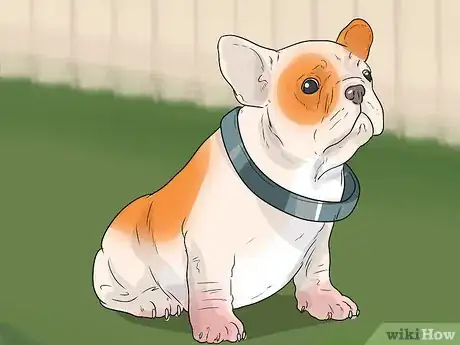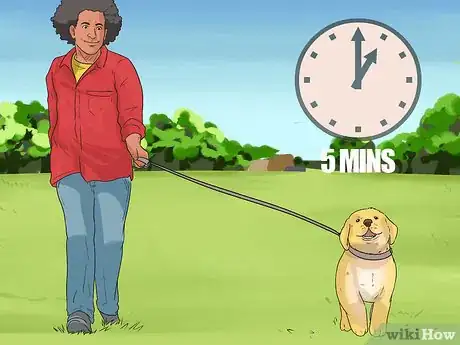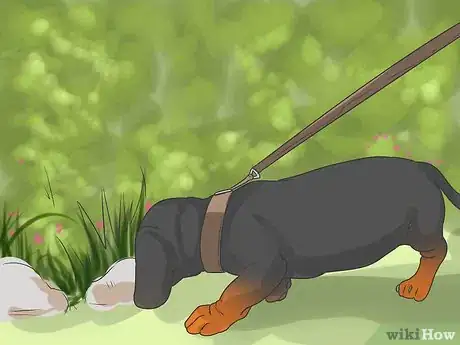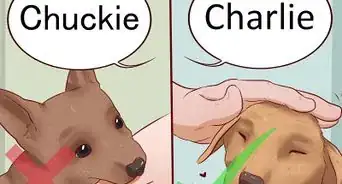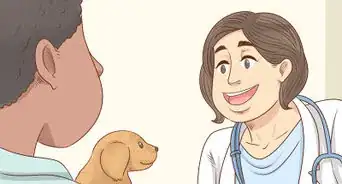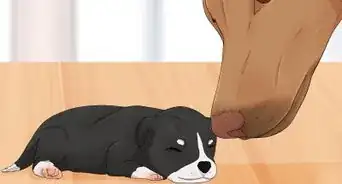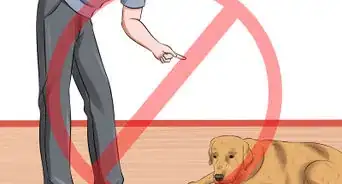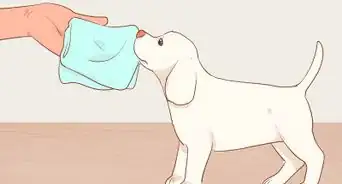This article was co-authored by David Levin. David Levin is the Owner of Citizen Hound, a professional dog walking business based in the San Francisco Bay Area. With over 9 years of professional dog walking and training experience, David's business has been voted the "Best Dog Walker SF" by Beast of the Bay for 2019, 2018, and 2017. Citizen Hound has also been ranked #1 Dog Walker by the SF Examiner and A-List in 2017, 2016, 2015. Citizen Hound prides themselves on their customer service, care, skill, and reputation.
There are 15 references cited in this article, which can be found at the bottom of the page.
This article has been viewed 63,336 times.
Puppies must be trained to wear a collar and walk on a leash. Train your puppies in your home, until they are ready to go out. Each puppy learns at his own pace. Be patient and teach good habits now so you can have fun throughout your dog's lifetime.
Steps
Introducing a Collar and Leash
-
1Choose a collar. Look for an adjustable nylon or leather collar. The exact collar you choose will depend on what type of dog you have. The collar should not be too tight or too loose. See if you can fit two fingers between the collar and your puppy's neck — if you can't, the collar is too tight.
-
2Let your puppy wear the collar for a little while. Your puppy may not like the feel of the collar at first. You may notice him trying to get out of the collar, scratching, or shaking his head. This is completely normal.[3] It may take a few days for your puppy to get used to the collar.
- Have your puppy wear the collar until he stops noticing it. Take the collar off once the puppy feels comfortable.
- Time how long it takes for your puppy to stop noticing the collar. The next day, leave the collar on for a little bit longer.
- Sometimes collars can hook around things and choke puppies, so keep an eye on your puppy to make sure he doesn't get caught on anything.
Advertisement -
3Distract your puppy when you put the collar on. As soon as you put the collar on, give your puppy a toy or a treat to distract him. This will take his mind off of the collar. Praise your puppy each time he wears his collar. This lets him know that the collar is a good thing.
- Always monitor your puppy when you are introducing him to a collar. You do not want him to choke or get it stuck on something.[4]
- When your puppy is not distracted by his collar, it is time to move on to leash training.
-
4Let your puppy wear the leash around the house. Attach the leash to his collar and let him walk around the house. This will help your puppy get used to the weight of the leash and the slight pulling. Play with your puppy during this time and offer him plenty of praise and a treat.[5]
- Take the leash off for a few minutes and continue to play. Then attach the leash again.
- Your puppy needs to associate the leash with play time and fun.
-
5Hold the leash while your puppy walks inside. Once your puppy is comfortable wearing the leash and the collar, do guided walks with your puppy. Hold the leash at your waist and have plenty of slack. You do not want to pull your puppy with the leash or put too much pressure on his neck.
- Never yank your puppy towards you with the leash.[6]
- Offer your puppy lots of praise and a treat when he does well with the leash.
-
6Train your puppy to start and stop. Get a firm grip on the leash and stand next to your puppy. Your puppy may move around for a little bit, but he will eventually sit still or lie down. Once your puppy is still, praise him or give him a treat. Then tell your puppy "Let's go," and take a step. Your puppy will get excited and want to move more, but wait until he is still again. Reward and praise him for stopping. Once your puppy can start and stop with one step, begin to increase the amount of steps.
- This teaches your puppy to start and stop when you stop and that you are in control.
- Once you reach 6 or 7 steps in a row, you are really walking your puppy on a leash.[7]
-
7Teach your puppy to feel pressure. If your puppy reacts negatively to you putting pressure on the leash, use treats to help him. Wave a treat and apply a little bit of pressure on the leash. When you apply pressure, gently pull the leash, but do not pull it so hard that your puppy is forced to come towards you. Your puppy will focus more on the treat than on the pressure around his neck.[8] T
- You may need to do this before you teach your puppy to start and stop with you.
EXPERT TIPDavid Levin is the Owner of Citizen Hound, a professional dog walking business based in the San Francisco Bay Area. With over 9 years of professional dog walking and training experience, David's business has been voted the "Best Dog Walker SF" by Beast of the Bay for 2019, 2018, and 2017. Citizen Hound has also been ranked #1 Dog Walker by the SF Examiner and A-List in 2017, 2016, 2015. Citizen Hound prides themselves on their customer service, care, skill, and reputation.Professional Dog Walker
 David Levin
David Levin
Professional Dog WalkerTeaching your puppy to make eye contact on command can be very helpful during walks. If you want your dog to walk right next to you, teach it solid eye contact on command. If the dog is looking at you, they can't be looking at something they shouldn't be, so you can use this when you're passing something you want them to ignore.
Walking Outside
-
1Complete your puppy's vaccinations. Your puppy should not be walking outside or going to dog parks unless he has been vaccinated. It is not safe for your puppy to come into contact with other animals. Your puppy will be done with his vaccinations at 14-16 weeks old.
- Typical vaccinations include the distemper/parvo (DHHP) and rabies. If your puppy will be around other dogs, he should get the Bordetella vaccination. Talk to your veterinarian about any other vaccinations your puppy may need.
-
2Adjust exercise time based on age. As a general rule, your puppy needs 5 minutes of exercise for every month of age. For example, a 4 month old puppy would need 20 minutes of exercise a day. However, the exercise needs of your puppy will vary based on the breed, energy level, and particular needs of your puppy. Consult your veterinarian to discuss the specific exercise needs of your puppy.[9] Too much exercise can cause your puppy to become too tired and can hurt his development.[10]
- Pay attention to how your puppy reacts to exercise. If he seems too tired, cut back. If he seems like he can continue, take him on an extra walk for 5 or 10 minutes.
- Keep track of time when you take your puppy out for a walk.
- Start with shorter walks and then build up as your puppy gets used to walking outside.
-
3Allow your puppy to explore during your outside walk. Your puppy will be observing all of the surroundings when you take him out for a walk. Allow him to stop and sniff things. Take treats with you on your walk. Reward your puppy when he listens and exhibits good behavior.[11]
- Walking outside is much different than walking around the house. Be patient with your puppy and allow him to adjust.
- Your puppy will find all of his new surroundings stimulating. He may refuse to move or just stand still.
- Don't allow your puppy to chew on sticks and acorns.
-
4Walk at a slow pace. Never jog or ride your bike when you walk your puppy. He is not ready for that fast pace and his joints are not strong enough. Wait until he is a year old before you start doing any of this.[12]
- As your puppy approaches one, speak to your veterinarian about exercising with him.
Handling Common Problems
-
1Stand still if your puppy pulls in the opposite direction. Your puppy may not want to follow your lead and begin to pull away from you. Instead of fighting your puppy, simply stand still. Do not move until your puppy comes back to you.[13] Do not yank or drag your puppy in this situation.
- If you tug against your puppy, he may start to think it is a game.
- You can reward your puppy's good behavior with praise and/or a treat.
- If your puppy won't stop pulling, you may start walking with a head halter or a front-hook harness.
-
2Keep your puppy from lunging during walks. Your puppy may go after another puppy, a person, or a car when you take him out for a walk. Place your body in between your puppy and the object that he is trying to get to. You can also try to distract your puppy with a toy or treat when you see him lunging for something.[14] [15]
- If your puppy tends to lunge at certain things, distract him before he has the chance to lunge.
- Use treats that your dog really likes and may not get often. This will provide a greater incentive.
- Use a front clip harness instead of flat collar or back clip harness, you will have more control of your puppy.
-
3Stop your puppy from chewing on his leash. Your puppy may chew on his leash during a walk. He may be doing this for fun, to gain attention, or because he is nervous. You have several options to change this behavior.[16]
- Use a chain leash instead of a fabric leash. Your puppy will not enjoy chewing on it as much.
- If your puppy is chewing as a fun tug game, attach two leashes during the walk. When your puppy begins to chew on the leash, release it and guide him with the other leash. The leash will no longer have any resistance and the game will not be fun anymore.
-
4Get your dog to walk beside you. Set the tone for your walk by walking out of the house first instead of letting your puppy lead you. If your puppy becomes excited, stand still and wait until he calms down. If your puppy begins to pull on your leash during the walk and trying to go in a different direction, stand still and wait for him to stop moving. Once your puppy calms down, say "Let's go" and begin to walk.[17] [18]
- You are teaching your puppy that you are the leader.
- Give your puppy a treat at your side when he is compliant. He will begin to stay there because he knows treats are at your side.
Community Q&A
-
QuestionMy Chi puppy is almost 2 weeks old, can I walk her in a public place?
 Community AnswerNot yet. Wait until she has had all of her vaccinations. She should be ready to walk in public at 14-16 weeks old.
Community AnswerNot yet. Wait until she has had all of her vaccinations. She should be ready to walk in public at 14-16 weeks old. -
QuestionCan I take my two-month-old puppy for a walk?
 Community AnswerNo. You should not walk your dog until she has had all of her shots. Consult your vet for advice and the right timing.
Community AnswerNo. You should not walk your dog until she has had all of her shots. Consult your vet for advice and the right timing. -
QuestionI live in an apartment with my Shih Tzu puppy, but I cannot take him for walks because poop is not allowed there. What can I do?
 Community AnswerYou could try to train him to use a litter box, but the most obvious solution is to simply pick up the poop after your dog goes to the bathroom outside. They make bags specifically for this purpose and if you're picking it up, no on should complain. Your other option is to take the dog for walks outside of the apartment complex property (you will still need to pick up its poop).
Community AnswerYou could try to train him to use a litter box, but the most obvious solution is to simply pick up the poop after your dog goes to the bathroom outside. They make bags specifically for this purpose and if you're picking it up, no on should complain. Your other option is to take the dog for walks outside of the apartment complex property (you will still need to pick up its poop).
References
- ↑ http://www.raisingspot.com/adopting/puppy-collar-and-leash
- ↑ http://www.americanhumane.org/animals/adoption-pet-care/dog-behavior/choosing-a-dog-collar.html
- ↑ https://www.purina.co.uk/dogs/behaviour-and-training/training-your-dog/walking-on-a-lead
- ↑ https://www.akc.org/expert-advice/training/the-best-collars-and-leashes-for-puppies-and-dogs/
- ↑ http://www.akc.org/learn/family-dog/teach-puppy-walk-leash/
- ↑ http://www.animalplanet.com/pets/how-to-leash-train-your-active-puppy/
- ↑ http://dogtime.com/dog-health/general/1530-dog-training-walking-on-leash-dunbar
- ↑ https://drsophiayin.com/blog/entry/my-puppy-wont-walk-on-leash-3-ways-to-train-your-puppy-to-love-her-leash/
- ↑ http://www.vetstreet.com/our-pet-experts/how-much-exercise-is-too-much-for-a-puppy?page=2
- ↑ http://www.thekennelclub.org.uk/getting-a-dog-or-puppy/general-advice-about-caring-for-your-new-puppy-or-dog/puppy-and-dog-walking/
- ↑ http://petcha.com/pet_care/how-to-walk-a-puppy/
- ↑ http://petcha.com/pet_care/how-to-walk-a-puppy/
- ↑ http://www.akc.org/learn/family-dog/teach-puppy-walk-leash/
- ↑ http://www.akc.org/learn/family-dog/teach-puppy-walk-leash/
- ↑ http://www.akc.org/learn/akc-training/tips-for-walking-your-distracted-dog/
- ↑ http://www.vetstreet.com/our-pet-experts/3-common-leash-problems-solved-pulling-mouthing-lunging
- ↑ http://www.perfectpaws.com/leash.html#.V2L8kbsrLIU
- ↑ http://www.petexpertise.com/dog-training-article-training-your-dog-not-to-pull-on-the-leash.html
About This Article
To start walking your puppy, begin by letting it wear the collar for a few minutes at a time so it gets used to the feel and weight. Once it gets use to the collar, put on the leash and walk it around the house. Make sure to give it treats and lots of praise so your puppy associates the leash with positive things. Then, take it on short, slow walks outside and allow it to explore its new surroundings. If your puppy pulls in the opposite direction, stand still until it comes back to you, then offer it a treat. For advice from our Veterinary co-author on how to keep your puppy from chewing on its leash, read on!

